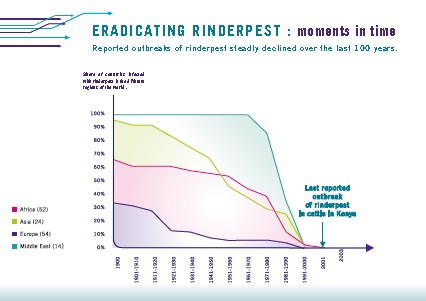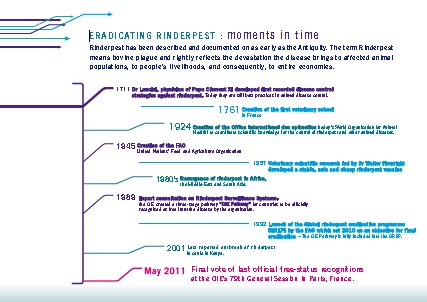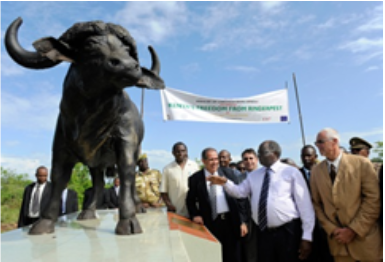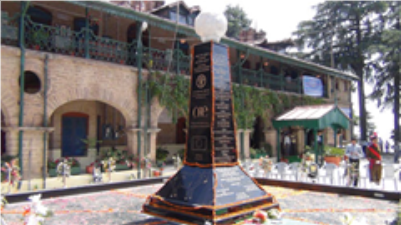Rinderpest
The first animal disease to have been eradicated, Rinderpest is highly contagious and has a long history of loss in animal populations and economic disruption. With a 100% death rate in some herds, the Rinderpest virus can be rapidly transmitted among cloven-hoofed animals (mainly cattle and buffalo). The far-reaching consequences of the “cattle plague” at social and economic levels led to the creation of the World Organisation for Animal Health, whose efforts and collaboration with international partners paved the way for the complete eradication of the disease, with the last case reported in 2001.
Links to Code and Manual
-
Terrestrial Code
-
Terrestrial Manual
The history of Rinderpest
Reports point to the origins of Rinderpest in Central Asia and its rapid spread to the rest of the continent and across Europe, following trade and migration routes. The disease was also reported in the Americas and Australia, with a lower prevalence. The fast-spreading disease triggered the start of extensive famines in Africa and hindered agricultural development in Asia, with livestock-dependent households bearing the brunt of its impact on food security and livelihoods.
Attempts to vaccinate animals against the disease were made as early as 1744 in the Netherlands and England and an effective vaccine was developed by the beginning of the twentieth century. However, it was after the 1920 outbreak of Rinderpest in Belgium that joint action to address the global concern received new impetus.
Because of its reach and magnitude, Rinderpest is considered the deadliest cattle disease in history.
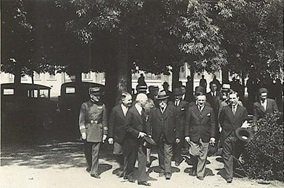
At the initiative of France, an international conference was held to which all countries were invited. The conference was held in Paris in May 1921. It called for the establishment, in Paris, of an international office for the control of infectious animal diseases.
What is Rinderpest?
Rinderpest is a highly contagious disease that had been known since humans initiated the domestication of livestock. The disease primarily affects primarily affects cattle, buffaloes, yaks, and several other domesticated and wild even-toed ungulates. In cattle, the most susceptible species, classical signs of the disease include fever, erosive lesions in the mouth, discharge from the nose and eyes, profuse diarrhea and dehydration, often leading to death within 10 to 15 days. In other species, rinderpest may show milder clinical signs. The “famous 4Ds” Depression, Discharges, Diarrhea & Death, together with fever (and/or mouth lesions) are typical clinical signs.
A basis for the creation of the World Organisation for Animal Health
The efforts to better understand the disease and to provide adequate prevention and control measures were the driving force behind the scientific breakthroughs unfolded within the 18th and the 19th century.
The vast economic and social repercussions of the disease led to the establishment of the Office International des Épizooties (OIE) in 1924 – which later became the World Organisation for Animal Health – in a bid to control infectious animal diseases at an international level. At the same time, several veterinary medicine schools were founded across Europe and Asia.
With the last identified case dating back to 2001, Rinderpest has been eradicated globally and is now the second infectious disease, after smallpox for humans, for which this remarkable achievement has been made.
The vaccination campaigns
In the 1960s, mass vaccination campaigns in Rinderpest affected countries, accompanied by movement control and stamping out measures, led to a substantial decline in disease cases. However, in the 1980s, a new devastating reappearance, wreaked havoc across the African continent due to the interruption of vaccination programmes.
The international response to the resurgence of the disease was led by the WOAH’s prominent action and the publication of international standards for the establishment of epidemiological surveillance systems.
In addition, a WOAH official disease status programme was created to recognise eligible Members as Rinderpest-free.
Timeline
Global Rinderpest Eradication Programme (GREP)
In the 1990s, the United Nations (UN) became actively involved in Rinderpest eradication efforts through the GREP coordinated by the Food and Agriculture Organization of the United Nations (FAO) in collaboration with the WOAH and the UN International Atomic Energy Agency (IAEA), with the aim of obtaining an official declaration of World Rinderpest eradication by 2011.
Ever since then, the WOAH has collaborated with FAO to ensure the maintenance of global freedom from the disease and the destruction or safe storage of all materials containing the Rinderpest virus.
The Rinderpest post-eradication strategy includes reviewing the remaining infectious samples, ensuring their sequestration and developing a contingency plan for unexpected outbreaks.
The declaration of a world free from Rinderpest
The world was officially declared free from Rinderpest in 2011 during the 79th WOAH General Session. The event, held annually in Paris, offered a platform for the presentation of the history of the disease and the goals accomplished in the path towards the formal recognition of Rinderpest free status.
Once the burden of societies across Africa, Asia and Europe, Rinderpest is only the second infectious disease, after Smallpox for humans, to have been wiped out globally, thanks to decades of internationally concerted effort.
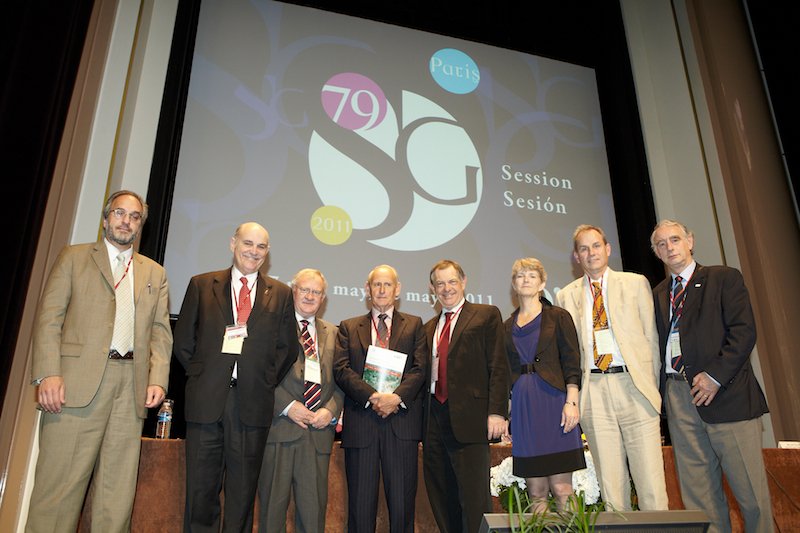
More information
-
Publication, Co-Publication
Rinderpest and its eradication
.pdf – 47 MB See the document
Maintaining global freedom from Rinderpest
Eradication does not mean that the Rinderpest story has come to an end. Although the Rinderpest virus no longer circulates amongst live animals, vaccines and biologic samples as well as virus stocks are still present in at least 15 laboratories across the world, mainly for the production of a vaccine reserve in the event of a renewed outbreak due to an accident or an act of bioterrorism.
Until these hazardous viral materials are either safely destroyed or transferred to one of the high-containment facilities, approved by WOAH and FAO, the world remains at risk of a reoccurrence of Rinderpest.
To never forget the threat posed by this deadly plague, the WOAH has developed an awareness campaign urging countries to remain vigilant about a potential comeback of the infectious disease.
‘Rinderpest: never turn back’ campaign
The purpose of the campaign ‘Rinderpest: never turn back’ is to make sure that everyone involved in animal health is fully aware of the challenges linked with a resurgence of the disease and of the vital role that everyone can play to preserve the legacy of the eradication.
The campaign objectives are:
- to ensure that Rinderpest occupies an appropriate place in veterinary education curricula;
- to maintain professional veterinary knowledge of Rinderpest and enable effective surveillance for rapid detection, notification and response in case of a resurgence of the disease;
- to guide laboratories all the way through the destruction of any stocks containing the Rinderpest virus.
Reasons for NOT keeping the Rinderpest virus in laboratories
A single release of rinderpest virus could:
Kill millions of cattle and endanger valuable wildlife
Undermine international veterinary biosecurity
Threaten animal welfare
Decrease food security and reduce rural livelihoods
Restrict local and international commerce
Cost millions of dollars to
re-eradicate
Delay other development goals
Reverse a historical achievement
Global commitment from Member Countries
All WOAH Members signed up to a Resolution at the WOAH General Session in May 2011, committing themselves:
- to destroy remaining virus or safely store them in a minimum number of approved high-containment laboratories;
- to remain vigilant to reoccurrences of the disease; and
- to cease all unapproved research activities.
A parallel Resolution was adopted by FAO in June 2011. The WOAH and FAO have joined hands to ensure that these actions are urgently and fully implemented to prevent this dreadful disease from resurfacing.
The WOAH, in collaboration with the FAO and with Member Countries, is committed to ensuring that the process is carried out in a reliable and transparent manner.
Designation of facilities as approved for holding Rinderpest virus containing material
In May 2019 at the WOAH General Session, the WOAH World Assembly of Delegates adopted Resolutions to maintain the designation of the following facilities as approved for holding Rinderpest virus containing material (subject to re-evaluation every 3 years).
Rinderpest Holding Facility for storing rinderpest virus containing material, excluding vaccine stocks
- African Union Pan African Veterinary Vaccine Centre (AU-PANVAC), Debre-Zeit, Ethiopia.
- Centre de coopération internationale en recherche agronomique pour le développement (CIRAD), Montpellier, France
- China Institute of Veterinary Drug Control/China Veterinary Culture Collection Center (IVDC), Beijing, China
- High Containment Facilities of Exotic Diseases Research Station, National Institute of Animal Health, Kodaira, Tokyo, Japan.
- USDA-APHIS, Foreign Animal Disease Diagnostic Laboratory (FADDL), Plum Island, New York, United States of America.
- The Pirbright Institute, United Kingdom.
Rinderpest Vaccine Holding Facility for storing only manufactured vaccines, vaccine stocks and material solely for their production:
- Pan African Veterinary Vaccine Centre African Union (AU-PANVAC), Debre-Zeit, Ethiopia
- Building for Safety Evaluation Research, Production Center for Biologicals; Building for Biologics Research and Development (storage), National Institute of Animal Health, Tsukuba, Ibaraki, Japan.
- Centre de coopération internationale en recherche agronomique pour le développement (CIRAD), Montpellier, France
- China Institute of Veterinary Drug Control/China Veterinary Culture Collection Center (IVDC), Beijing, China
WOAH Resolutions
adopted during WOAH General Sessions (GS)
- Declaration of global eradication and implementation of follow-up measures (Resolution No. 18/79th GS, 2011)
- Derogation allowing the regulated movement of attenuated vaccine seed stock out of a BSL3 facility to an FAO-WOAH approved facility (Amendment to Resolution No.18)
- Recognition of the Rinderpest disease status of members and non-members (Resolution No.15/79th GS, 2011)
- The WOAH role in maintaining world freedom from Rinderpest (Resolution No. 33/80th GS, 2012 )
- Procedure for designation of facilities as approved for holding RPV containing material (Resolution No. 23/82th GS, 2014)
- Designation of facilities as approved for holding RPV containing material (Resolution No. 25/83th GS, 2015, page 52)
- Amendments to the annex “Guidelines for Rinderpest Virus Sequestration” of Resolution No. 18, 2011 (Resolution No. 21/85th GS, 2017)
- Designation of facilities as approved for holding Rinderpest virus containing material (Resolution No. 20/86th GS, 2018)
- Designation of Facilities Holding Rinderpest Virus Containing Material to Maintain Global Freedom from Rinderpest (Resolution No. 23/87th GS, 2019)
- Extension to the Designation of Facilities Holding Rinderpest Virus Containing Material to Maintain Global Freedom from Rinderpest (Resolution No. 24/87th GS, 2019)
- Extension to the Designation of Facilities Holding Rinderpest Virus Containing Material to Maintain Global Freedom from Rinderpest (Resolution No. 27/89th GS, 2022)
- Extension to the Designation of Facilities Holding Rinderpest Virus Containing Material to Maintain Global Freedom from Rinderpest (Resolution No. 27/90th GS, 2023)
Disease-free status with regard to Rinderpest
Rinderpest was declared as eradicated worldwide by the WOAH and FAO in May and June 2011, respectively. This was ten years after the identification of the last case in Kenya.
The list of Rinderpest-free WOAH Members, as well as non-Members can be consulted in the RESOLUTION NO.15 (79th General Session of World Assembly, May 2011)
In accordance with the decision taken by the World Assembly at the 79th WOAH General Session, Members are now exempted from annual reconfirmation for Rinderpest free status.
-
.pdf – 162 KB See the document
Questionnaires for recovery of free status or risk assessment in case of recurrence of rinderpest
In the event of re-emergence of rinderpest, all Members without a case will have to provide a risk assessment to WOAH in order to remain free from rinderpest. WOAH developed a questionnaire template for risk assessment (for countries without a case) as well as for recovery of rinderpest-free status (for countries infected with rinderpest virus), both endorsed by the Scientific Commission for Animal Diseases.
Should a rinderpest outbreak reoccur, Members without a case should provide their risk assessment to WOAH as soon as possible and within two months at the latest.
-
Questionnaire
Application for recovery of free status for rinderpest
.docx – 552 KB See the document -
.docx – 552 KB See the document
Global Rinderpest Action Plan
The joint WOAH-FAO Global Rinderpest Action Plan (GRAP) lays out the roles and responsibilities of all relevant stakeholders in the five stages of the emergency management cycle( Prepare, Prevent, Respond, Recover) related to a potential re-emergence of Rinderpest.
The GRAP is largely based on the WOAH Terrestrial Animal Health Code chapter on Infection with Rinderpest virus along with elements from the FAO Good Emergency Management Practice publication, and complements all national and regional contingency plans. This document enables Veterinary Services to identify and prioritise gaps to be addressed in order to best prepare for, respond to, and mitigate the consequences of a Rinderpest outbreak in the post-eradication era. It includes provisions for the management and deployment of the Rinderpest vaccine reserves, held by WOAH-FAO designated Rinderpest Holding Facilities.
Joint Advisory Committee
Central to the WOAH’s role in the post-eradication era are the FAO-WOAH Rinderpest Joint Advisory Committee (JAC) and the WOAH Reference Laboratories for Rinderpest, both providing technical support.
The WOAH and the FAO have formed a JAC with seven of the most highly qualified individuals on Rinderpest. The JAC also provides guidance to the WOAH and FAO Directors General in, among other things, approving Rinderpest research proposals and high-containment facilities responsible for safeguarding the virus.
Joint Advisory Committee (JAC) Meeting reports
Videos
Publications
-
Publication, Strategic Plan
Global Rinderpest Action Plan 2018
.pdf – 13 MB See the document -
Publication
No more deaths from rinderpest – Bulletin 2011-4
.pdf – 3 MB See the document -
Publication
Rinderpest Eradication
.pdf – 3 MB See the document

